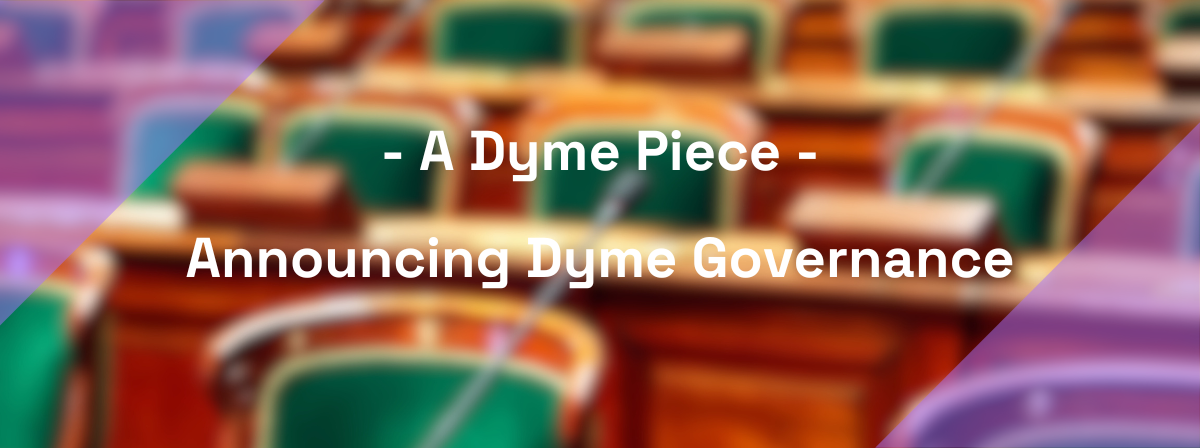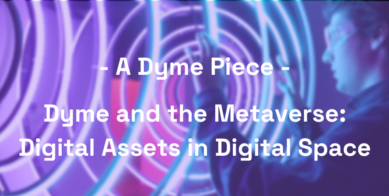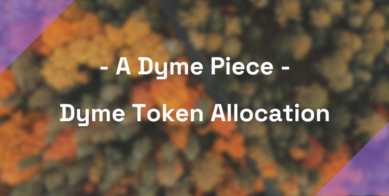Dyme Protocol governance premises and practices
Today, we share the governance premises and practices for Dyme. This complements both the design we recently shared about Dyme’s token allocation and the tokenomics paper we published. This completes the trilogy of Dyme’s foundational papers.
Introduction
Dyme’s platform is an environmentally friendly, cost-efficient, high-throughput, low-latency permissionless blockchain. Dyme is part of the Cosmos Interchain, built on Ignite and using Cosmos SDK. We believe Dyme expands on the Cosmos “Internet of Blockchains” positively. It provides economic models and exemplars of use for Web 3 projects. It further offers a reserve cryptocurrency for those projects to use.
The governance model described herein was designed to work hand-in-glove with Dyme’s economic and incentive model (or tokenomics model.) Dyme’s novel governance module shifts governance to a democratic footing from the outset. Dyme’s governance model seeks to avoid oligarchical control problems plaguing the web3 community. In no place is this oligarchical control seen more clearly than in the various disfranchisements caused by the effective centralization of governance.
Dyme’s formation documents align with this design, linking legal and on-chain software into a cohesive whole. As a memberless foundation based in the Cayman Islands, the Dyme Foundation is governed by the Dyme community through Dyme’s novel governance module. Dyme’s formation documents describe the only path to a board resolution through the on-chain governance process. Further, barring an act deemed to violate the law, the Board must authorize resolutions.
To that end, today we share the design of Dyme’s governance. This complements both the design we recently shared about Dyme’s token allocation and the tokenomics paper we published. This completes the trilogy of Dyme’s foundational papers.
Definitions
In this document, unless the context otherwise requires:
Blockchain: a digital ledger maintained by a set of validators that remains correct even if some of the validators are malicious. Each party stores a copy of the ledger on their computer and updates it according to the rules defined by the protocol when they receive blocks of transactions. Blockchain technology aims to ensure the ledger is correctly replicated, meaning that each honest party sees the same version of the ledger at any given moment.
BFT: Byzantine Fault-Tolerance. Byzantine faults within distributed systems are some of the most difficult to deal with. A Byzantine Fault-Tolerant consensus algorithm guarantees safety for up to a third of Byzantine, or malicious, actors.
Cosmos: A decentralized network of independent parallel blockchains, each powered by BFT consensus algorithms like Ignite consensus.
Council of Advisors: advisory body established under the section “Advisory Phase.”
DAO: Decentralized Autonomous Organization.
Dyme: When styled with typical capitalization, this refers to the Dyme Foundation and its various operating companies.
Dyme DAO: Decentralized Autonomous Organization created by Dyme.
DYME: When styled in all capital letters, this refers to the cryptocurrency of the Dyme DAO that can be held in the Dyme wallet.
Dyme Protocol: The cryptocurrency and associated business logic and governance are termed the Dyme Protocol.
Dyme Wallet: wallet holding DYME.
Dyme Community Member, DCM, Dymeian: Members of the Dyme DAO community who hold at least one DYME in their Dyme Wallet.
Software Code: Means any and all source code or executable code for client code, server code, and middleware code (as those terms are generally used in the software development industry), and any and all database schemas, database backup, test scripts, other scripts, architecture diagrams, data models and other documentation related thereto.
Tokenomics: Derived from token and economics, it is the study of the supply, distribution, utility, valuation, and incentives of cryptocurrencies.
Governance Premises
Governance Premise 1: Democratic, not oligarchical.
Dyme shall be governed using the democratic “one wallet, one vote” principle rather than an oligarchic “one token, one vote” principle.
Notes: This is a central tenet of Dyme. It allows us to take a strong statement like “for the people” and treat it seriously.
Onboarding and KYC elements of obtaining a Dyme wallet will make the creation of multiple wallets challenging. Onboarding will require a unique email address and mobile number for each wallet (except for wallets controlled by either Dyme or an approved project such as Lifetoken). KYC may require a unique bank account or government identification. This gives further support to the premise.
As described in the governance model below, various initial timing models and a council of advisors will serve as a relief valve in the early days of the DAO launch.
Governance Premise 2: DYME is both a governance token and a cryptocurrency.
This dualistic use of DYME is intended to align the protocol’s governance with the community’s financial interest.
Note that this is not unique. The Cosmos ATOM does this. Where Dyme’s voting module is novel, the staking and consensus modules are consistent with other Interchain blockchains. This allows validators and other Dymeians confidence in understanding the rights of DYME holders where the DYME is locked up for validating and escrowing.
As Dyme permits escrow of DYME for validators, validators, at their sole discretion, may choose to provide a reward for such escrow. This reward is described as “earn” in the Dyme economy visualization:
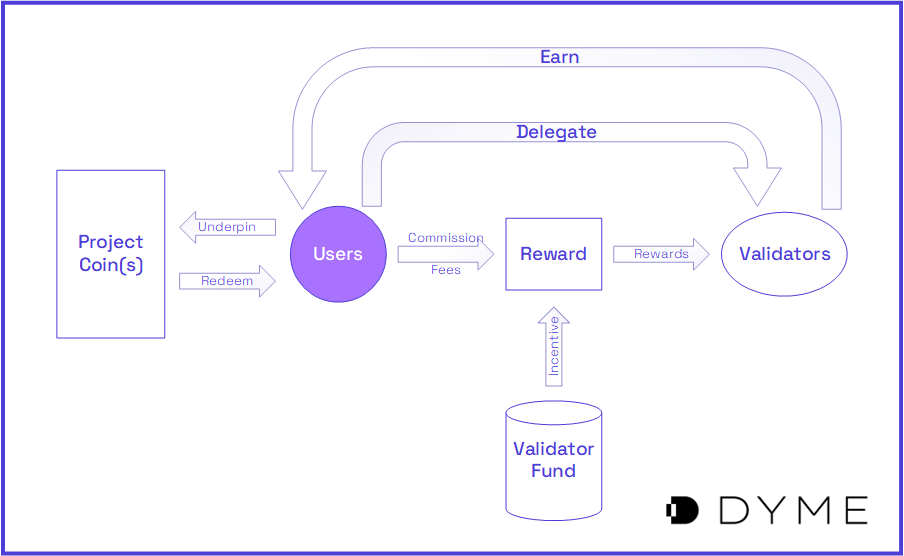
In an abundance of clarity, escrow carries risk. Among these risks, a validator may put forward a “no with veto” vote that risks the burning of DYME. They may also lose staked DYME as a result of a malicious act.
Governance Premise 3: By the people.
The governance of Dyme is based on the community. Any person or organization who holds at least 1 DYME in their Dyme wallet is a Dymeian. A fixed number of Advisors shall be selected from among the Dymeians and as the first governance matters.
Notes: The amount of DYME held in their wallet is initially fixed at 1 DYME, which excludes as a DCM any wallet with a fraction of a DYME.
The Dyme wallet is the only wallet that holds DYME today. This is expected to evolve such that DYME will exist in “foreign wallets.” The mechanism for voting shall be updated to reflect the inclusion of other wallets when integrated into Dyme.
The amount of DYME needed to be a Dymeian shall be subject to amendment by a governance vote.
Formation of the Council of Advisors
The first governance vote should occur when the total number of Dymeians reaches twenty (20). The initial council of advisors should be seated for twelve (12) months (two council advisors); twenty-four (24) months (two council advisors); thirty-six (36) months (two council advisors); and forty-eight (48) months (two council advisors). The advisors seated should number eight (8) in total.
Advisors shall only be elected from among Dymeians. Subsequent advisors should hold their position for twelve (12) months. In all cases, the vote for advisors shall be “one wallet, one vote.”
Governance Model
The model is a narrative of a logical flow, beginning with a proposal and ending with implementation. The governance model, memorialized in software code, is aligned with legal formation documents. Together, they are designed to comport with law and regulation, as required.
Proposal Phase
Any Dyme Community Member may submit a proposal on the Dyme network for others to view. The only cost of raising a proposal is the transaction fee required to place the proposal on the Dyme blockchain.
The Proposal Phase has a period of 14 days. In that time, a proposal must gain at least ten percent (10%) of Dymeians to provide an affirmative expression that they wish to see the proposal advance to voting. If fewer than ten percent (10%) of Dymeians indicate support during this phase, the proposal shall not advance to the Voting Phase.
Any proposal submitted within 30 days of a meeting of the Dyme Board of Directors is held in this phase until after the meeting of the Dyme Board of Directors.
Affirmative expressions will be recorded on-chain.
A governance vote should set the proposal period and the number of affirmative expressions for advancing to the voting phase.
Voting Phase – First Iteration
The Voting Phase has a period of 14 days. In that time, Dymeians may vote on the proposal. Each Dymeian may cast their one vote in one of the following ways: yes, no, veto, and abstain. Voters can also change their vote right up until the closing of this period.
A vote of yes is a vote in support of the proposal.
Conversely, a vote of no is a vote opposed to the proposal.
A vote of veto is a vote opposed to the proposal that also conveys a veto vote used during the Tallying Phase.
Finally, a vote of abstain is a vote of neither support nor opposition to the proposal.
A vote of yes, no, or abstain is free of cost and escrow. A vote of veto requires a deposit of one thousand (1,000) DYME, which carries a risk of being burned during the Tallying Phase.
Tallying Phase
The Tallying Phase lasts seven days, though it is expected to be nearly instantaneous given the nature of on-chain voting. In that time, a tally of the votes will be assessed against the following logic flow:
Quorum: Thirty-five percent (35%) or more of all Dymeians voted by the end of the voting period and proceed to the next step. Otherwise, the vote fails.
Threshold: If more than fifty percent (50%) of the summation of the yes, no, and veto votes voted yes, proceed to the next step. Otherwise, the vote fails.
Veto: If fewer than thirty-three-point four percent (33.4%) of the summation of the yes, no, and veto votes voted veto, proceed to the next step AND burn all of the veto deposit DYME held. Otherwise, release the DYME held from the veto deposit to the depositing wallets, AND the vote fails.
If the vote tally reaches this phase, it advances to the Advisory Phase.
Notes: The quorum value should be settable by a governance vote. Early completion of the tally phase is acceptable.
Advisory Phase
The Advisory Phase has a period of 14 days. During that time, advisors may meet in whatever mode they deem to discuss the vote. The Council of Advisors shall put forward the approved proposal according to the following outcomes:
No advice: In this case, the Council of Advisors has no guidance on implementing the proposal. This is the default.
Returned for further voting: In this case, a majority of the Council of Advisors has assessed in its absolute discretion that the proposal would have a material impact on the Dyme Protocol.
Advice: The Council of Advisors guides the proposal’s implementation in this case. This guidance is provided to facilitate the efficient implementation of the approved proposal by the Board of Directors. A majority of advisors voting in favor of the advice is needed for this outcome to be recorded.
If the proposal reaches this point, it advances to the Board Phase.
Returned for Further Voting Phase (if needed)
If triggered by the Advisory Phase, the Returned for Further Voting Phase lasts 14 days. In that time, Dymeians may vote on the proposal. Each Dymeian may vote volumetrically equivalent to the whole number of DYME in their wallet. In this case, the number of DYME a wallet holds determines how much influence their vote will have on the outcome of a proposal. Voters can also change their vote right up until the closing of this period.
Dymeians may vote in one of four ways: yes, no, veto, and abstain. A Dymeian shall vote all of their votes in one and only one way.
A vote of yes is a vote in support of the proposal.
Conversely, a vote of no is a vote opposed to the proposal.
A vote of veto is a vote opposed to the proposal that also conveys a veto vote used during the Tallying Phase.
Finally, a vote of abstain is a vote of neither support nor opposition to the proposal.
A vote of yes, no, or abstain carries zero cost. A vote of veto requires a deposit of one thousand (1,000) DYME, which has a risk of being burned during the Tallying Phase.
Tallying Phase
The Tallying Phase lasts seven days, though it is expected to be nearly instantaneous given the nature of on-chain voting. In that time, a tally of the votes will be assessed against the following logic flow:
Quorum: If 35% or more of the total DYME voted by the end of the voting period, proceed to the next step. Otherwise, the vote fails.
Threshold: If more than 50% of the summation of the yes, no, and veto votes voted yes, proceed to the next step. Otherwise, the vote fails.
Veto: If fewer than 33.4% of the summation of the yes, no, and veto votes voted veto, proceed to the next step AND burn all of the veto deposit DYME held. Otherwise, release the DYME held from the veto deposit to the depositing wallets, AND the vote fails.
If the vote tally reaches this phase, it advances to the Board Phase.
Notes: The quorum value should be settable by a governance vote.
Board Phase
When the Board of Directors meets, they shall provide a resolution and steps to implement the proposal.
Note: It is reasonable that the Board will require third-party vendors to implement nearly every proposal.
Alignment between formation documents, corporate governance, and software code
To allow the governance of Dyme by the holders of DYME is the objective of the Dyme DAO. To that end, the software code representing governance functions of the Dyme Protocol has been described in this document.
Alignment between software code and legal formation and governance documents is similarly essential to achieve the objective of the Dyme DAO. The Foundation’s Memorandum of Association, Articles of Association, and Bylaws are aligned with software code.
This effort of drafting legal formation and governance documents with software code was daunting, underscoring the weight given to the action by the early contributors to the project. As is typical of software development, architecture changes as code is written. This document is published only after the software code is materially complete, allowing us to make iterative changes to the software code and then align those changes with the formation and governance documents that legally bind the organization’s behavior.
The effort also considered the legal obligations of companies in the jurisdictions where they reside, including the legal obligations of directors and supervisors. This is made clear in the example provided in the introduction, where the phrase “barring an act deemed to violate law” is used. The formation documents oblige the Board to carry out the will of the DAO as articulated through the governance process and to view resolutions only from the software code’s governance process.
To the best of our understanding, this alignment is novel in the market. We expect it will become a gold standard of DAO operation.
Closing
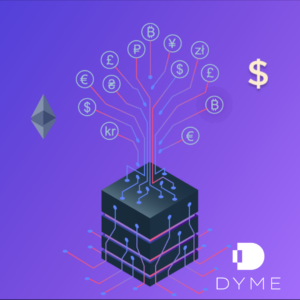
As designed, Dyme’s economic model operates smoothly in sync with Dyme’s code. Of significant note, Dyme’s validator fund and commission mechanisms work hand-in-glove to promote honest actions and inhibit malicious activities. Dyme’s governance further amplifies this by embracing democratic voting rather than oligarchical supervision.
The ultimate goal is to serve Web3’s growing projects and their next billion users.
